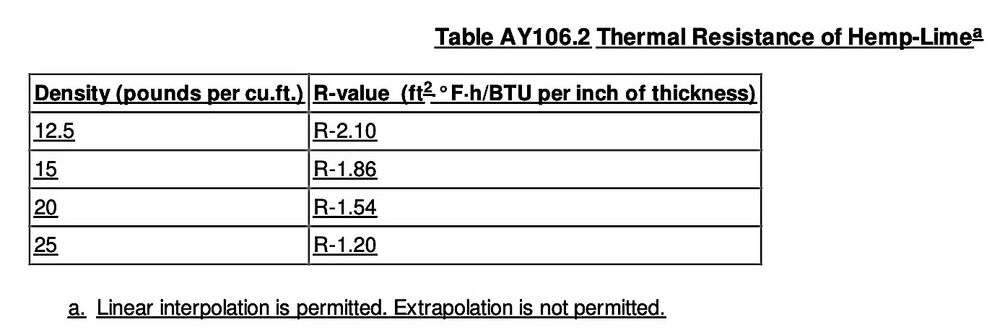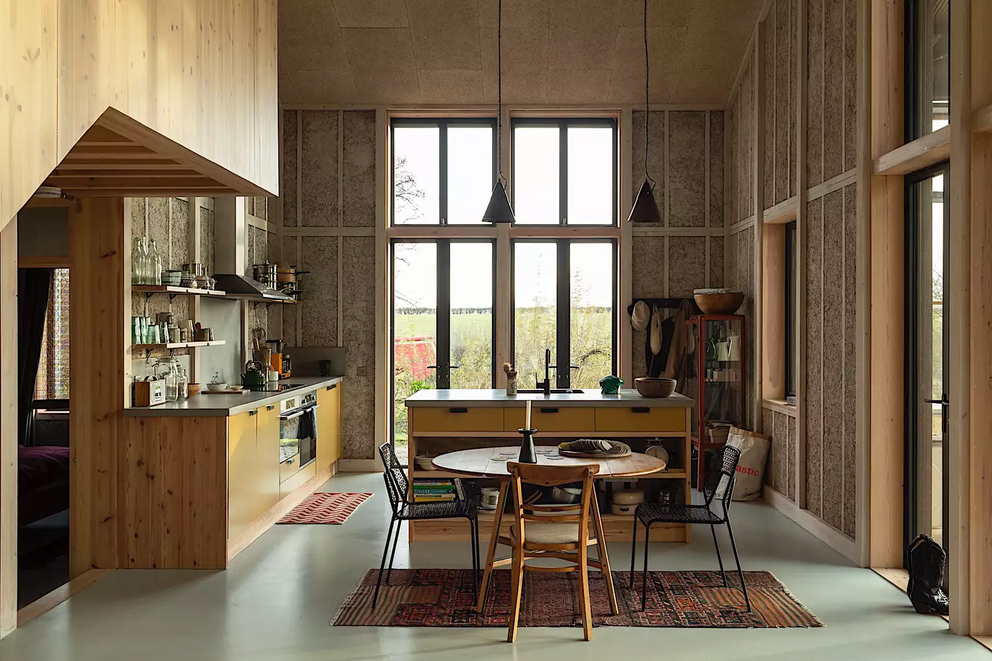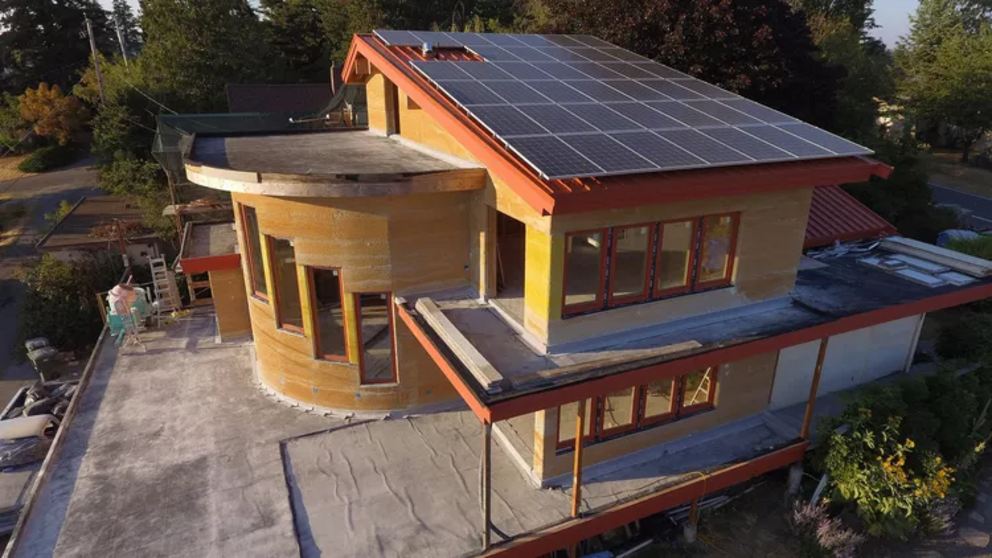Hempcrete gets a boost in US residential building code
The Highland Hemp House in Bellingham, Washington, is under construction.
This could be a big boost for carbon-storing and regenerative architecture.
This could be a big boost for carbon-storing and regenerative architecture.
Every time I write about alternative construction materials, a commenter will ask: "What about hemp?" The main reasons I didn't cover the hemp scene is because it reeked of the hippie aesthetic that we tend to avoid. More importantly, it wasn't easy to find or use in the U.S.
But in October 2022, hempcrete was added as an appendix to the U.S. residential building code, utilized by 49 out of 50 states, and will be in the 2024 International Residential Code (IRC).1 According to the approval, "the committee considered that this is another technology similar to that of the straw bale and the cob wall construction. The industry will be able to provide safer building with uniform requirements being codified as an appendix as opposed to being an alternate method [where the architect or designer has to convince the building official that it is OK] This will make it easier for building departments to review plans for permitting this option."
Here's a sample wall from the code appendix:
 International Residential Building Code
International Residential Building Code
While many sources are saying that hempcrete is now approved for U.S. residential building codes, building expert Chris Magwood of Builders for Climate Action tells Treehugger that being in the appendix is not quite the same as being in the code.
"It is voluntary to adopt appendices even once a new code is adopted. So there will be many places for which this is not a direct code inclusion for a long time, if ever," says Magwood. "What is good is that it lends legitimacy to the material, if not sure-fire code acceptance. Often, code officials are reassured by this kind of appendix because it gives them confidence that this has been reviewed by experts, and the provisions give them some benchmarks to measure the performance of the plans they are reviewing. So it's a great step forward."
Hempcrete is such an exciting material. In "The Benefits of Building a Hempcrete House," Treehugger's Jim Gunshinan described it as "an energy-efficient, low-impact, water-smart building material that offers a smaller carbon footprint than other home building materials."
But it is much more than that. It is one of those materials that author Bruce King described in the New Carbon Architecture as "building out of sky," or materials that take carbon from the carbon dioxide in the air, sunlight, and water—which, through the process of photosynthesis, are turned into plants that we can turn into building materials.
"All of these emerging technologies and more arrive in tandem with the growing understanding that the so-called embodied carbon of building materials matters a great deal more than anyone thought in the fight to halt and reverse climate change. The built environment can switch from being a problem to a solution."
On its own, it is not a structural material but acts as a solid infill material. The Endeavour Centre's free encyclopedia explains:
"The hurd or shiv of the hemp plant is the woody core left over once the fiber has been stripped away. This hurd is lightly coated with hydrated (and sometimes hydraulic) lime and water and the resulting mix is placed into formwork on the wall. Slip forms can be moved up the wall as hempcrete is added. The material is stable in the wall immediately after tamping. The finished insulation is left exposed on both sides of the wall in order to dry. The hempcrete provides a dense, flat surface and makes an ideal substrate for plasters. Sheet barriers and more conventional siding and wall covering can also be used."
They note it takes a long time to dry, as much as one week per inch of thickness, and that the insulation value varies significantly with the degree of compaction, as does the new building code appendix:

An R-value of 2.1 per inch isn't great; fiberglass batts are rated at 3.1 to 3.4. But there are other advantages—it handles moisture well and is antifungal. Many builders suggest that the R-value is actually much higher due to its thermal mass, but as the Endeavour Centre noted, "While it is true that in situ thermal performance can be different from measured R-value, the same is true of any insulation/wall system. Thermal resistance cannot be improved by thermal mass."
Hemp is a low-impact crop, and most importantly to this Treehugger, according to the Carbon Smart Materials Palette, it stores about 325 kilograms of carbon per metric ton. However, there are questions about the total amount of carbon sequestered because of the lime that holds it all together.

Hemp walls are often plastered but can be left exposed and, in the hands of a good architect, can be beautiful. British architect Paloma Gormley demonstrated this at Margent Farm. In her recent book, "Material Reform," Gormley writes about how natural materials like hempcrete are useful for carbon storage and regenerative design:
"If you build using a material palette based on composite petrochemical components, glue, sticky tape, glass, concrete and steel, then there is little or no chance these elements will return into the ecosystem in a way which enables regeneration. Buildings made with bio-based materials, in contrast, are situated in time in an entirely different way: the aim is to keep the bulk of materials out of the carbon cycle for as long, or longer, than it takes for them to regenerate in the biosphere, but accept and accommodate their eventual disintegration."
Hemp is still hard to find in the U.S., even though it is legal to grow it now. However, it can be imported from Canada and Europe. And now that it is in the building code appendix, it might become more popular.
But Magwood isn't sure that hempcrete will take off for residential use. "I don't think that hempcrete will ever play a large role in the residential market. The fact that it is a composite material that uses a lime-based binder means that it is less insulative than other options and more expensive," says Magwood. "Somebody has to mix, form, and cure the material, whether that happens on-site or in pre-fab units or blocks. To meet basic minimum code requirements in colder climates requires at least a 12-inch thick wall, and getting to high-performance levels will mean 16 inches or more, so a builder needs more of a material that is already more expensive."
"I can see potential for hempcrete panels to play an important role in commercial construction, where the great fire performance of the material (the benefit of being coated in lime) can provide a biogenic, carbon-storing option for large buildings that does not carry the fire performance concerns of "dry" biogenic insulation," adds Magwood. "I can also see a lot of potential for hempcrete "sheet" materials like http://calmura.ca/ in both residential and commercial construction. It could be a great option for replacing plywood/OSB for sheathing and for sound and fire separation in building interiors. Also, a great way to cover sections of mass timber that need additional fire protection."
Magwood certainly dampened my enthusiastic vision of hempcrete turning every building into bio-based carbon-storing regenerative structures that help reduce climate change instead of adding to it, but it is a step in the right direction. In his article "Sequestering Carbon in Buildings," Vermont-based builder Ace McArleton wrote:
"It is absolutely possible to design, construct, repair, and maintain high performing, energy-efficient and durable buildings with not only low- or zero-embodied carbon materials, but with materials, that sequester – or store – carbon, giving that building a net-positive carbon footprint. Our buildings then become tools in the project of global drawdown of CO2; they become reservoirs for CO2 and help to reduce and reverse climate change effects."
Hempcrete is one of those materials that can contribute to regenerative, carbon-storing buildings. So get those farmers planting hemp now! We might need a lot of it in 2024.
Fact checked by Haley Mast
For full references please use source link below.

